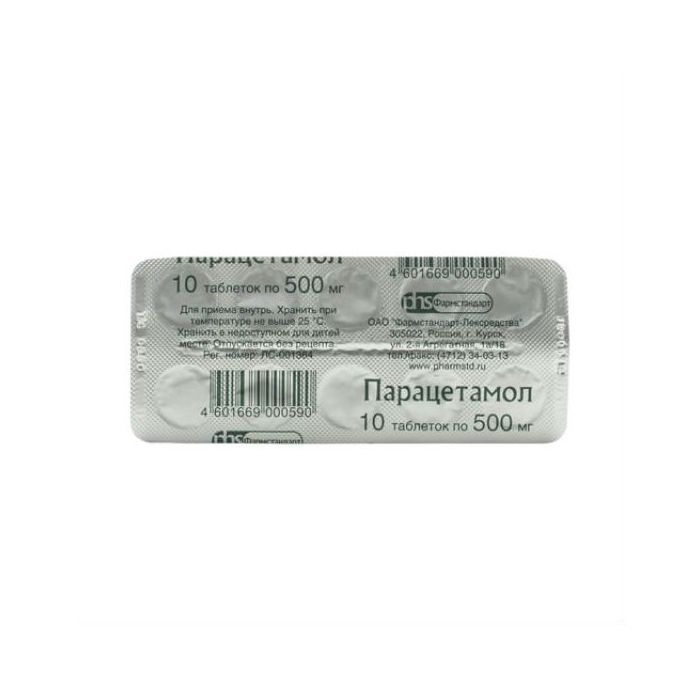Paracetamol | Paracetamol tablets 500 mg 10 pcs.
Special Price
$26
Regular Price
$33
In stock
SKU
BID494456
Latin name
Paracetamol
Paracetamol
Latin name
Paracetamol
packaging 10 pcs
Indications
Mild to moderate pain syndrome (arthralgia, myalgia, neuralgia, migraine, toothache and headache, algodismenorrhea), fever for infectious and inflammatory diseases (including viral infections).
contraindications - individual hypersensitivity to the components of the
drug (for children under 6 years of age) .
Precautions
Renal and hepatic failure, viral hepatitis, alcoholic liver damage, alcoholism, benign hyperbilirubinemia (Gilbert, Dubin-Johnson and Rotor syndromes), glucose-6-phosphate dehydrogenase deficiency, old age, pregnancy, lactation.
Use during pregnancy and lactation
Paracetamol crosses the placental barrier. To date, there has been no adverse effect of paracetamol on the fetus in humans.
Paracetamol is excreted in breast milk: the content in milk is 0.04-0.23% of the dose taken by the mother.
If you need to use paracetamol during pregnancy and lactation (breastfeeding), you should carefully weigh the expected benefits of therapy for the mother and the potential risk to the fetus or child.
In experimental studies, the embryotoxic, teratogenic and mutagenic effects of paracetamol have not been established.
Composition
Composition per tablet
active substance: paracetamol - 500 mg
excipients: potato starch, croscarmellose sodium (croscarmellose sodium), povidone (low molecular weight polyvinylpyrrolidone medical), stearic acid, talc.
Side effects
Nausea, vomiting, abdominal pain.
Allergic reactions (skin rash, itching, urticaria, Quincke edema).
Rarely - leukopenia, agranulocytosis, thrombocytopenia.
With prolonged use in large doses - hepatotoxic and nephrotoxic (interstitial nephritis and papillary necrosis), hemolytic anemia, aplastic anemia, methemoglobinemia, pancytopenia.
Drug Interaction
Inductors of microsomal oxidation in the liver (phenytoin, ethanol, barbiturates, flumecinol, rifampicin, phenylbutazone, tricyclic antidepressants) increase the production of hydroxylated active metabolites, which leads to the possibility of severe intoxication with small overdoses.
Prolonged use of barbiturates reduces the effectiveness of paracetamol.
Co-administration with ethanol increases the risk of acute pancreatitis.
Microsomal oxidation inhibitors (including cimetidine) reduce the risk of hepatotoxic action.
When taken with non-steroidal anti-inflammatory drugs, including salicylates, the nephrotoxic effect of paracetamol increases.
Diflunisal increases the plasma concentration of paracetamol by 50%, which increases the risk of hepatotoxicity.
Paracetamol enhances the effect of indirect anticoagulants and reduces the effectiveness of uricosuric drugs.
Overdose
Symptoms: pale skin, nausea, vomiting, anorexia, abdominal pain impaired glucose metabolism, metabolic acidosis. Symptoms of liver dysfunction may occur 12-48 hours after overdose. In severe overdose - liver failure with progressive encephalopathy, coma, death acute renal failure with tubular necrosis arrhythmia, pancreatitis. Hepatotoxic effect in adults is manifested with intake of 10 g or more.
Treatment: gastric lavage no later than 4 hours after poisoning, adsorbent intake (activated charcoal). The introduction of methionine is actual within 8-9 hours, acetylcysteine - within 8 hours. The need for additional therapeutic measures is determined depending on the concentration of paracetamol in the blood, as well as the time elapsed after its administration.
Storage conditions
In a dry, dark place at a temperature of no higher than 25 РC.
The Expiration of
is 3 years.
Deystvuyuschee substances
Paracetamol
dosage form
dosage form
tablets
Pharmstandard-Leksredstva, Russia
Paracetamol
packaging 10 pcs
Indications
Mild to moderate pain syndrome (arthralgia, myalgia, neuralgia, migraine, toothache and headache, algodismenorrhea), fever for infectious and inflammatory diseases (including viral infections).
contraindications - individual hypersensitivity to the components of the
drug (for children under 6 years of age) .
Precautions
Renal and hepatic failure, viral hepatitis, alcoholic liver damage, alcoholism, benign hyperbilirubinemia (Gilbert, Dubin-Johnson and Rotor syndromes), glucose-6-phosphate dehydrogenase deficiency, old age, pregnancy, lactation.
Use during pregnancy and lactation
Paracetamol crosses the placental barrier. To date, there has been no adverse effect of paracetamol on the fetus in humans.
Paracetamol is excreted in breast milk: the content in milk is 0.04-0.23% of the dose taken by the mother.
If you need to use paracetamol during pregnancy and lactation (breastfeeding), you should carefully weigh the expected benefits of therapy for the mother and the potential risk to the fetus or child.
In experimental studies, the embryotoxic, teratogenic and mutagenic effects of paracetamol have not been established.
Composition
Composition per tablet
active substance: paracetamol - 500 mg
excipients: potato starch, croscarmellose sodium (croscarmellose sodium), povidone (low molecular weight polyvinylpyrrolidone medical), stearic acid, talc.
Side effects
Nausea, vomiting, abdominal pain.
Allergic reactions (skin rash, itching, urticaria, Quincke edema).
Rarely - leukopenia, agranulocytosis, thrombocytopenia.
With prolonged use in large doses - hepatotoxic and nephrotoxic (interstitial nephritis and papillary necrosis), hemolytic anemia, aplastic anemia, methemoglobinemia, pancytopenia.
Drug Interaction
Inductors of microsomal oxidation in the liver (phenytoin, ethanol, barbiturates, flumecinol, rifampicin, phenylbutazone, tricyclic antidepressants) increase the production of hydroxylated active metabolites, which leads to the possibility of severe intoxication with small overdoses.
Prolonged use of barbiturates reduces the effectiveness of paracetamol.
Co-administration with ethanol increases the risk of acute pancreatitis.
Microsomal oxidation inhibitors (including cimetidine) reduce the risk of hepatotoxic action.
When taken with non-steroidal anti-inflammatory drugs, including salicylates, the nephrotoxic effect of paracetamol increases.
Diflunisal increases the plasma concentration of paracetamol by 50%, which increases the risk of hepatotoxicity.
Paracetamol enhances the effect of indirect anticoagulants and reduces the effectiveness of uricosuric drugs.
Overdose
Symptoms: pale skin, nausea, vomiting, anorexia, abdominal pain impaired glucose metabolism, metabolic acidosis. Symptoms of liver dysfunction may occur 12-48 hours after overdose. In severe overdose - liver failure with progressive encephalopathy, coma, death acute renal failure with tubular necrosis arrhythmia, pancreatitis. Hepatotoxic effect in adults is manifested with intake of 10 g or more.
Treatment: gastric lavage no later than 4 hours after poisoning, adsorbent intake (activated charcoal). The introduction of methionine is actual within 8-9 hours, acetylcysteine - within 8 hours. The need for additional therapeutic measures is determined depending on the concentration of paracetamol in the blood, as well as the time elapsed after its administration.
Storage conditions
In a dry, dark place at a temperature of no higher than 25 РC.
The Expiration of
is 3 years.
Deystvuyuschee substances
Paracetamol
dosage form
dosage form
tablets
Pharmstandard-Leksredstva, Russia
Submit your review to Earn 10 Reward Points click here to login
Write Your Own Review

